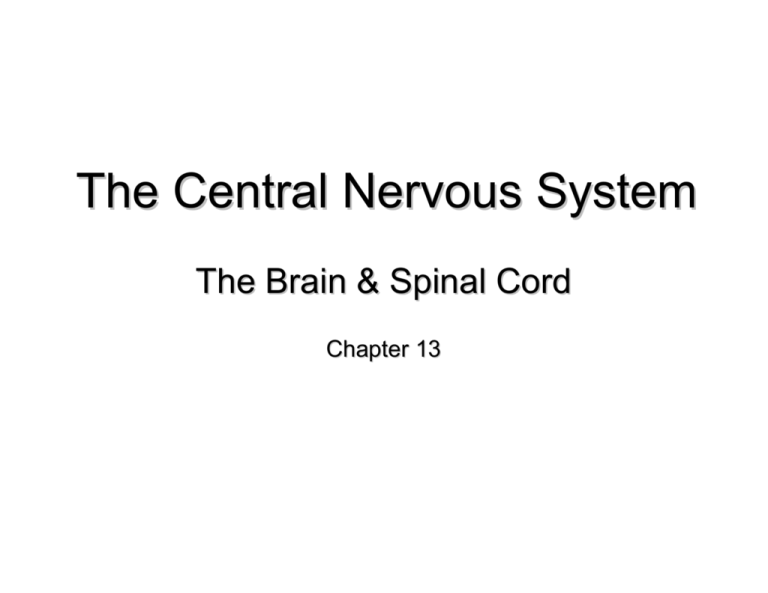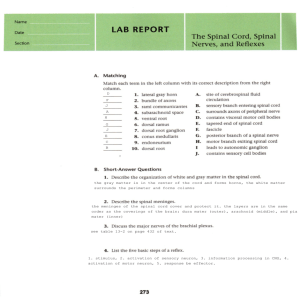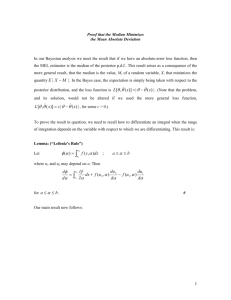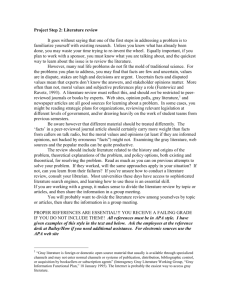The Central Nervous System
advertisement

The Central Nervous System The Brain & Spinal Cord Chapter 13 Meninges 20 days 28 days 35 days Forebrain telencephalon (cerebrum - the cerebral hemispheres) diencephalon (thalamus, hypothalamus) Midbrain mesencephalon (tubular, upper brain stem) Hindbrain metencephalon (pons, cerebellum) myelencephalon (medulla oblongata, lowest part of brain stem) Cerebrum (telencephalon) 85% of brain mass Function(s): perceive information, direct motor responses, memory, center of intellect, language, consciousness Cerebrum is subdivided by convolutions into itself. Sulcus – grooves or depressions Fissure – deep sulci Gyrus – rounded elevations Longitudinal fissure – divides cerebrum into the R and L hemispheres. Transverse fissure – separates cerebrum from cerebellum Central sulcus – separates the frontal lobe from the parietal lobe. Precentral gyrus – voluntary movement Postcentral gyrus - pain Transverse fissure Lobes of the Cerebrum Frontal – “somatomotor” functions (voluntary movement), intellectual functions, aggression, sexual behavior, olfaction, motor area, Broca’s area of speech (on left side only; coordinates speech muscles) Parietal – abstract reasoning (mathematics), use of symbols for communication (“language”), body sensory awareness including taste, touch, temperature, pressure, pain Occipital – vision “visual cortex”, receives, interprets and discriminates visual stimuli from the optic tract. Temporal – auditory area “auditory cortex”, formation of emotions, memory processing. Lateral view Medial view Cerebral Cortex Gray matter – unmyelinated, outer surface (2-5 mm thick). Contains 75% of nueron cell bodies. Follows the sulci, gyri and fissures of cerebrum. White matter – located under cortex, comprises bulk of cerebrum. Consists of bundles of myelinated nerve fibers. White matter – 2 major types of white matter fibers Commissures – tracts of fibers connecting left and right hemispheres, largest is the corpus collosum. This tract covers both hemispheres and is roofing over the lateral ventricles. Association fibers – bundles of white matter that connect anterior and posterior cortical area. Projection fibers – connects cortical area with lower brain and spinal cord. Sensory input reaches cortex through these fibers. Thalamus and cortex communicates by this pathway. Forms corona radiata. Projection fibers – corona radiata is largest mass of white matter in brain. Basal nuclei (ganglia) are areas of gray matter buried deep in white matter. Help regulate and coordinate aspects of movement, especially starting and stopping voluntary movement. Also regulates the intensity of movements. Parkinson’s Disease – basal nuclei provide too little motor drive, slow movement/tremors of limbs. Huntington’s Disease – overstimulation of the motor drive, limbs jerk unstoppably. Ventricles – expansions of the brain’s central cavity filled with cerebrospinal fluid. Lateral ventricles – lie in cerebral hemispheres. Third ventricle – lies in diencephalon. Fourth ventricle – lies in hindbrain. Cerebral aqueduct – lies in mesencephalon. Connection for 3rd and 4th ventricles. Cerebrospinal Fluid • A clear, largely acellular fluid with less density and protein than plasma. • Provides shock-absorbing function. • About 150 ml. Excess production of CSF or lack of drainage can cause hydrocephaly. • CSF is secreted by specialized capillaries from the pia mater called choroid plexuses. Route of Circulation • I and II ventricles to the III ventricle to the IV ventricle to the spinal cord and subarachnoid space. • CSF is reabsorbed in arachnoid villi into the blood filled superior sagitall sinus (dural sinus). Diencephalon – forms the central core of the forebrain and is surrounded by the cerebral hemispheres. Consists of 3 paired structures (thalamus, hypothalamus, epithalamus. Thalamus – egg shaped, dense gray matter, forms superolateral wall of 3rd ventricle. 12 major nuclei with axons that reach the cortex. Processes all incoming impulses from sensory pathways (except olfactory). “gateway to cerebral cortex” Diencephalon – forms the central core of the forebrain and is surrounded by the cerebral hemispheres. Consists of 3 paired structures (thalamus, hypothalamus, epithalamus) Epithalamus – secretes melatonin which induces sleep. Hypothalamus – controls autonomic nervous system, emotional response, behavior, endocrine system. Regulates body temperature, hunger, thirst sensations, sleep-wake cycles. Formation of memory. Epithalamus The Brain Stem – midbrain, pons and medulla oblongata. Midbrain (mesencephalon) – short section between diencephalon and pons. Acts as a relay center between forebrain and hindbrain. Cerebral aqueduct passes through here. Pons (part of metencephalon) – relay of impulses to and from the medulla oblongata and the cerebrum and between cerebrum to cerebellum. The Brain Stem – midbrain, pons and medulla oblongata. Medulla oblongata (myelencephalon) – continuation of the superior portion of the spinal cord and forms the inferior part of the brain stem. Begins at foramen magnum continues superior. Contains all ascending (sensory) and descending (motor) white matter tracts that connect the spinal cord with the brain. medulla oblongata: Vital and non-vital body functions. Vital Functions – respiration center (pattern and rate), cardiac center (rate and force), vasomotor center (blood vessel diameter, blood pressure regulation by smooth muscle stimulation or inhibition). Non-vital Functions – sneezing, coughing, vomiting, swallowing, hiccuping. Many of these are controlled by the hypothalamus. The Brain Stem – midbrain, pons and medulla oblongata. Axons cross over (R and L) such that the right cerebral cortex controls muscles on the left side, etc. Cerebellum (metencephalon) – 2nd largest portion of brain. Located below occipital lobe, posterior to pons. Made up of 2 lateral hemispheres, gray matter at surface and deep white matter. Cerebellum (metencephalon) – Functions are equilibrium and position sense, fine movement, control of muscle tone and overall coordination of muscular activity in response to proprioreceptive input (coordinates antagonistic muscles). The Spinal Cord Basic structure of the spinal cord in cross section. 2 median grooves: A deep anterior median fissure and a shallow posterior median sulcus. These extend length of cord forming lateral halves. posterior median sulcus anterior median fissure DRAW! The basic structures of the spinal cord show lateral symmetry, with white matter on the outside and gray matter on the inside. posterior median sulcus White matter Gray matter anterior median fissure Gray matter (“butterfly”) consists of neuron cell bodies, synapses, nonmyelinated neurons (interneurons, neurons that connect sensory and motor neurons that acts as a reflex processor). posterior median sulcus White matter Gray matter anterior median fissure Gray matter: Ventral Horn (anterior horn) – contains cell bodies of motor neurons. Motor information out through axons that leave the ventral root. posterior median sulcus White matter Gray matter Ventral horn anterior median fissure Gray matter: Dorsal Horn (posterior horn) – contains interneurons. Receives sensory input from sensing neurons whose cell bodies lie in the dorsal root ganglia and axons enter the dorsal root. posterior median sulcus Dorsal horn White matter Gray matter Ventral horn anterior median fissure Gray matter: Gray commissure – horizontal bar connecting the wings of the gray matter. Connects right and left sides. posterior median sulcus Dorsal horn White matter Gray matter Gray comminsure Ventral horn anterior median fissure Gray matter: Lateral horn – smaller lateral protrusion found in thoracic and lumbar levels only. Autonomic motor neurons to smooth and cardiac muscle, and glands. posterior median sulcus Dorsal horn White matter Gray matter Lateral horn Gray comminsure Ventral horn anterior median fissure Central canal – continuous with ventricles of brain and contains spinal fluid. Canal disappears before adulthood. posterior median sulcus Dorsal horn White matter Gray matter Lateral horn Gray comminsure Central canal Ventral horn anterior median fissure White columns (matter) – consists mostly of myelinated neurons. Divided by gray matter in three distinct regions (anterior, posterior, lateral funiculi) that contain longitudinal bundles of nerve fibers (axons). posterior median sulcus Dorsal horn White matter Gray matter Lateral horn Gray comminsure Central canal Ventral horn anterior median fissure White columns (matter) – Ascending tract – sensory (afferent) into to brain. Pain relief? Descending tracts – motor (efferent) info from brain to muscles/glands. Ascending tracts (senory in) posterior median sulcus Dorsal horn White matter Gray matter Lateral horn Gray comminsure Central canal Descending tracts (motor out) Ventral horn anterior median fissure Direction of movement of messages: Gray matter – horizontal Ascending tracts (senory in) White matter - vertical posterior median sulcus Dorsal horn White matter Gray matter Lateral horn Gray comminsure Central canal Descending tracts (motor out) Ventral horn anterior median fissure






